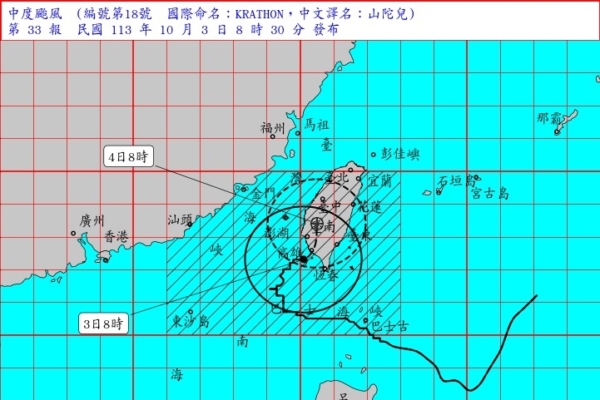Taiwanese meteorologist Wu Derong stated today that Typhoon Santolo’s center is expected to make landfall near Kaohsiung this morning, with its intensity continuing to weaken rapidly into a moderate typhoon. People should remain cautious of strong winds and heavy rain across the island, especially in southern Taiwan.
As Typhoon Santolo approached Taiwan, all 22 counties and cities announced closures for work and schools on the 3rd, following the same measure from the 2nd. The Central Disaster Response Center warned of the need to guard against strong winds and heavy rains, with Taitung and Pingtung Counties elevating their landslide warnings to red on 44 fronts. The national toll from the storm stood at 2 dead, 102 injured, and 2 missing.
The Fourth Army Command, responsible for defense and disaster relief in southern Taiwan, announced on the 2nd that together with local governments in Tainan, Kaohsiung, and Pingtung, they have deployed 1,165 troops for preventative evacuations in landslide-prone areas. They urged timely reporting from field officers for precise deployment of rescue efforts.
Associate professor Wu Derong from the Department of Atmospheric Sciences at National Central University explained on TV that the latest modeling from various countries (US, Canada, UK, Japan) showed a divergence in predicted paths. Official forecasts from different countries did not entirely follow the modeling, with paths diverging within 24 hours.
Wu pointed out that factors such as weak steering flows and disruption of low-level circulation may pose challenges in pinpointing the storm’s center, although the wind threat is decreasing after 24 hours. Attention should be paid to localized heavy rains and downpours.
According to the latest “Path Potential Forecast” from the Central Weather Bureau at 5:00 am on the 3rd, the typhoon’s center is projected to land near Kaohsiung in the morning, with potentially damaging winds and intense rain still revolving around the eyewall, urging enhanced preparedness.
Due to Taiwan’s interception of moisture convergence and terrain-induced friction, Typhoon Santolo is expected to rapidly weaken into a moderate typhoon, posing a continued risk of strong winds and heavy rains across the island, particularly in southern Taiwan. By the 4th, wind force from Typhoon Santolo will no longer be the primary threat; attention should be focused on isolated heavy rains or downpours.
At 8:30 am today, the Central Weather Bureau reported that Typhoon Santolo had slightly weakened over the past 3 hours with a reduction in its radius of gales. The center was located southwest of Kaohsiung, moving north-northeast. The gale circle had reached parts of southern regions such as Chiayi and Nantou on land and posed threats to regions including Hsinchu, Nantou, Yilan, Hualien, Taitung, and Penghu islands. The typhoon was anticipated to further weaken.
Areas under alert on land include Hsinchu, Miaoli, Taichung, Changhua, Nantou, Yunlin, Chiayi, Tainan, Kaohsiung, Yilan, Hualien, Taitung, Pingtung, Hengchun Peninsula, and Penghu.
At sea, the Taiwan Strait, northeastern seas of Taiwan, southeastern seas of Taiwan, Bashi Channel, and Dongsha Islands are on high alert for maritime activities.
The Central Weather Bureau cautioned that coastal areas and outlying islands around Taiwan were experiencing notably higher waves with the potential for long swells, particularly with over 8-meter waves in the southwestern coastal areas and the Hengchun Peninsula. Waves over 5 meters were observed in northern and eastern coastal regions, including Penghu and Matsu, advising against seaside activities.
For strong wind alerts on land, gusty winds were prevalent across various regions, especially in Tainan, Kaohsiung, and Pingtung coastal areas in the morning, expecting around 14 levels of strong gusts.
The Central Weather Bureau emphasized precautions against typhoon storm surges and seawater backflows in southwestern coastal areas; warnings were issued for Pingtung, Kaohsiung, and Tainan against powerful gusts and brief heavy rainfall. Outdoor objects, signboards, fences, and scaffolding should be secured, while balcony plants rearranged safely.

